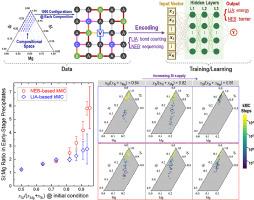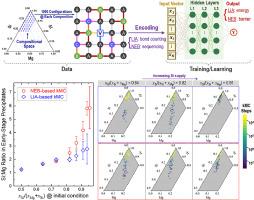Machine learning-augmented modeling on the formation of Si-dominated Non-β″ early-stage precipitates in Al-Si-Mg alloys with Si supersaturation induced by non-equilibrium solidification
IF 8.3
1区 材料科学
Q1 MATERIALS SCIENCE, MULTIDISCIPLINARY
引用次数: 0
Abstract
Recent experiments have shown that Al-Si-Mg alloys solidified under high cooling rates may lead to the nucleation of Si-enriched clusters that are remarkably different from the conventional Mg-Si co-clusters (e.g. β″ particles), and yet the responsible mechanism remains to be elucidated. Here we tackle the problem using a multiscale modeling framework that integrates atomistic modeling, energy landscape sampling, and lattice-based kinetic Monte Carlo (kMC) simulation. The migration energy barriers for vacancy-mediated diffusion amid complex local chemical environments are predicted on-the-fly using a surrogate machine learning model. We discover that the actual vacancy-Si migration barriers are much lower than those assumed in the classic linear interpolation approximation. Such a strong deviation from conventional wisdom, in conjunction with differing Si solute composition, can lead to a great variety in the nucleated early-stage precipitates. More specifically, a high-level supersaturation of Si solute (i.e. ) would lead to an unexpectedly high enrichment of Si in the nucleated clusters with the Si:Mg ratio up to 5∼6; while at a lower-level supply of Si solute the Mg-Si co-clusters (i.e. Si:Mg ratio around 1∼2) are nucleated instead. These findings provide a viable explanation for the diverse types of early-stage precipitates observed in various experiments, from Si-enriched precipitates in high-pressure die cast Al alloys to β″ particles in conventional casting and/or heat-treated alloys. The implications of our findings are also discussed.


非平衡凝固诱导的硅过饱和铝硅镁合金中硅主导的非β″早期析出物形成的机器学习增强模型
最近的实验表明,在高冷却速率下凝固的铝硅镁合金可能会导致富含硅的团簇成核,这种团簇与传统的镁硅共团簇(如β″颗粒)有明显不同,但其作用机制仍有待阐明。在此,我们采用多尺度建模框架来解决这一问题,该框架整合了原子建模、能谱采样和基于晶格的动力学蒙特卡罗(kMC)模拟。在复杂的局部化学环境中,利用代用机器学习模型即时预测了空位介导扩散的迁移能垒。我们发现,实际的空位-硅迁移能垒远低于经典线性插值近似所假设的能垒。这种与传统智慧的强烈偏差,再加上不同的硅溶质成分,会导致成核的早期沉淀物种类繁多。更具体地说,硅溶质的高过饱和度(即 xSi/(xSi+xMg)>0.75xSi/(xSi+xMg)>0.在硅溶质供应量较低的情况下,镁硅共生团簇(即硅镁比约为 1∼2)反而会成核。从高压压铸铝合金中的富硅沉淀到传统铸造和/或热处理合金中的β″颗粒,这些发现为各种实验中观察到的不同类型的早期沉淀提供了可行的解释。我们还讨论了这些发现的意义。
本文章由计算机程序翻译,如有差异,请以英文原文为准。
求助全文
约1分钟内获得全文
求助全文
来源期刊

Acta Materialia
工程技术-材料科学:综合
CiteScore
16.10
自引率
8.50%
发文量
801
审稿时长
53 days
期刊介绍:
Acta Materialia serves as a platform for publishing full-length, original papers and commissioned overviews that contribute to a profound understanding of the correlation between the processing, structure, and properties of inorganic materials. The journal seeks papers with high impact potential or those that significantly propel the field forward. The scope includes the atomic and molecular arrangements, chemical and electronic structures, and microstructure of materials, focusing on their mechanical or functional behavior across all length scales, including nanostructures.
 求助内容:
求助内容: 应助结果提醒方式:
应助结果提醒方式:


